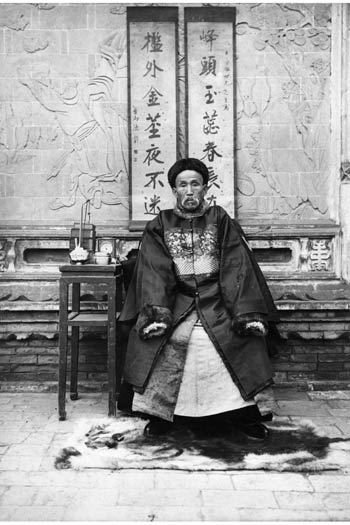
May 9–August 3, 2012
China Initiatives

In 1908, thirty-one-year-old American adventurer Robert Sterling Clark organized a scientific expedition to Northern China for the purpose of creating a detailed geographical survey of the area, recording daily meteorological observations; photographing the people, places, and landscapes; and collecting samples of the flora and fauna.
Clark was fascinated with the Chinese nation and its people, but like many Westerners of his day he felt that he had only glimpsed the surface of this rich and ancient culture. Trained as a civil engineer, Clark brought a scientist’s curiosity and method to the planning of his expedition, assembling a talented professional team that included a surveyor, a doctor and meteorologist, an artist, and the famed British naturalist Arthur de Carle Sowerby, as well as some thirty additional support staff.
Departing from the city of Taiyuan in Shanxi province, the Clark expedition traversed Shên-kan (the provinces of Shaanxi and Gansu), reaching as far westward as Lanzhou before returning to Taiyuan. In all, the team covered nearly 2000 miles (3200 km), primarily on horse and mule. A complete documentation of their journey, Through Shên-kan: The Account of the Clark Expedition in North China, 1908–9, was published in 1912. Despite having devoted a number of years to planning the expedition, Clark never again returned to China. In 1910 he settled in Paris and began collecting art, an interest that would become the passion of his life.
Continuing its commitment to global outreach and scholarship, the Clark commemorated the 100th anniversary of the expedition by presenting in China an exhibition of historic images printed from the original photographs in the collection of the Smithsonian Institution Archives in Washington. Researchers believe that all of these photographs were taken during the Clark expedition of 1908–9, although little is known about some of the images.
In conjunction with this installation, the Clark also presented rare original copies of Through Shên-kan to Chinese municipalities along the expedition route, and has translated the book into Mandarin (both versions of the book can be viewed in digital form on the Library pages of the Clark website). The book has also served as inspiration for contemporary Chinese photographer Li Ju, who retraced the original Clark expedition route and re-photographed many of the sites documented in Through Shên-kan, recording the changes that have occurred in northern China during the past 100 years. In 2013 the Clark will share masterpieces from its collection of French Impressionist paintings with leading museums in Beijing and Shanghai, furthering the relationship between the institution’s artistic legacy and the country Sterling Clark studied so carefully early in his life.
